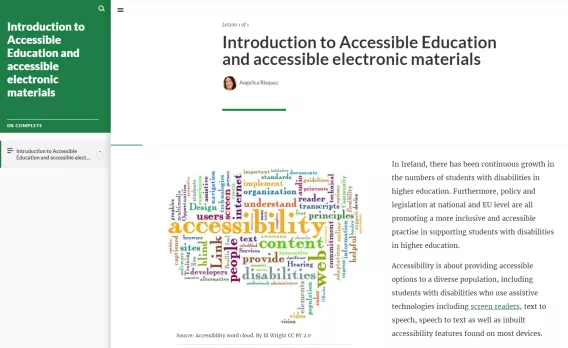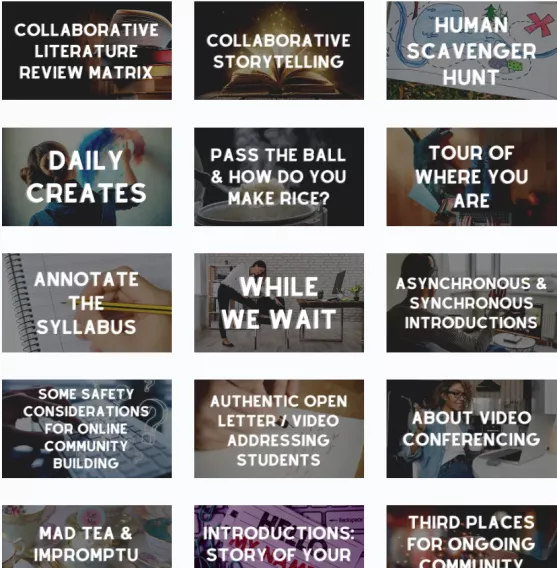By David Moloney.
Reading time: ~5 minutes.
Featured Image Source - 'Framework for online pedagogy' by Bonnie Stewart & Dave Cormier.
In this post:
3 Key Tips
Welcome everyone!
In their slightly tongue-in-cheek yet deeply meaningful and relevant 'Framework for online pedagogy' depicted in the image above, Bonnie Stewart, Assistant Professor of Online Pedagogy & Workplace Learning, University of Windsor, Canada, and Dave Cormier, Digital Learning Specialist based at the same university, urge academic staff to focus on three fundamentals this semester
- Keep things Simple, Equitable, and Engaging.
View Bonnie & Dave's slides from their recent keynote presentation at the Association of Learning Technology's Summer Summit (#altcsummit).
How might you approach accomplishing those things in your wholly or partly online (blended) teaching experience this semester at UL?
1. Keep things Simple
One of the key messages they presented was that crisis, in the times we live in, is not a one size fits all phenomenon. Some of us will face drastically different circumstances as a result of the Covid-19 pandemic. Regardless of our role or profession, educators and students alike may face significant stressors ahead - health, family, finance, housing, employment, education, grief, etc. With regard to digital teaching and learning this semester, this can similarly be represented - there is no one size that will fit all of our contexts.
Faculty Learning Technologists in UL have each been working diligently to provide a ‘VLE Module template’ for your faculty (VLE = Virtual Learning Environment i.e. Sulis or Moodle). These VLE module templates are now available to you and serve the purpose of providing you with a structured, well-designed and consistent copy & edit style module that you can begin populating with your own contents and activities. In addition, some module templates include accompanying instructions to help you along the way.
Find out more about the VLE module template available within your faculty from your faculty-level learning technologists:
- AHSS >> Contact Jess jess.beeley@ul.ie
- EHS >> Contact Adrienne adrienne.horan@ul.ie
- KBS >> Contact Rob robert.dalton@ul.ie and Erin erin.king@ul.ie
- S&E >> Contact Morteza morteza.rezaeizadeh@ul.ie and Maura maura.griffin@ul.ie
Many of you have already engaged in module planning, design and preparation work for your forthcoming modules and programmes. Students will draw commonalities and comparison between the different modules that they experience across their entire programme of study, therefore, where possible, we encourage continued communication between colleagues working on the same programme.
Clarity and consistency are absolutely key when it comes to digital teaching and learning. This applies equally to learning experiences both at the module- and at the programme-level. One suggestion in advance of the 'Go Live' date with your students might be to recruit the help of a critical friend who can cast an honest eye, through a student lens, over your module or programme as it appears on the VLE. A colleague on your programme team might fulfill this role if asked. They may spot something that you had not anticipated in time for you to remedy it. The planning checklists for Course Directors, Module Leaders and Teaching Assistants each identify important common areas to address and are of great benefit to use in any such review.
2. Keep things Equitable
One way to keep your digital teaching equitable is to become aware of the move towards Accessible Education for all students.
Accessible Education is the process of designing courses and developing flexible teaching methods to meet the needs of a diverse range of students.
One helpful approach for this which has gathered significant momentum is Universal Design for Learning (UDL). The core principles of UDL derive from the field of neuroscience and are designed to support the diversity and variability of learners.
UDL strongly emphasises a need for increased accessibility. In utilising the principles of UDL, course materials are designed to be accessible to everyone, not just students with disabilities.
Specifically for the UL audience, LTF members have developed a dedicated online resource which introduces the concept of Accessible Education and provides guidance on creating accessible online materials.

In terms of design considerations and equity, it's also worth noting that not all our students will have equal internet connectivity, meaning that synchronous (live) online events, such as live lectures, will not be possible to attend for many students. For further information about the risk of poor broadband accessibility, explore this tweet thread from Donal Palcic, Economics Lecturer and Assistant Dean International, KBS:
The eight HEIs with the lowest proportion of at risk students are located in Dublin, while HEIs located in the west or midlands have highest proportion of at risk students which is a function of the catchment areas of HEIs and the unequal distribution of high quality broadband pic.twitter.com/gsFbDBB7H9
— Donal Palcic (@DonalPalcic) September 10, 2020
3. Keep things Engaging
To empower students to realise their full potential we need to engage and establish rapport when teaching online. By providing opportunities for reciprocal exchange you may find that you learn quite a bit from the insights and experiences your students have to offer.
In addition to cultivating student engagements with the subject matter you teach, building a sense of community among your students is important. Consider ways that you might try to cultivate peer-to-peer engagement through the activities and interactions that you develop. A fantastic set of free online community-building activities for educators have been made available by Equity Unbound which include introductory activities, icebreaker/warm-up activities, activities for ongoing conversations and for setting the tone, etc.

Concluding Thought
One summary takeaway from the first post in our Quick Tips for Teaching Online series is to Keep things simple, equitable and engaging for both you and your students this coming semester and beyond.
Remember, this is still teaching and it is still learning, and you have much of what you need already to hand. On this occasion, some of it may be taking place in a slightly different arena for both you and your students and throughout the course of this semester you may find that you have to adapt what you do a little bit to best accommodate to this new environment and the opportunities that it holds.
Through this Quick Tips for Teaching Online series we aim to guide and signpost you as best we can. Thank you for reading. Join us again for the next instalment, coming soon!
‼ Bonus...(for those that read until the end!)
Remember to own the ums and aws in your recorded lectures and lessons. There are humans at both sides of the screen, and humans appreciate humanity.
We think this short funny outtake video does a good job of summing up that feeling you get after making a small mistake (or many) during recording! (turn volume up on video for sound)
See you next time!
Find Out More
Follow the LTF on Twitter.
Access curated resources beneath each theme of "The EDTL Approach" (access them using 'The EDTL Approach' dropdown menu near the top of that website).
Watch recordings of previous EDTL community webinars.
Join the EDTL community. At the time of writing, membership is at ~550 members, predominantly academic staff.
Follow the EDTL conversation on Twitter #IUADigEd